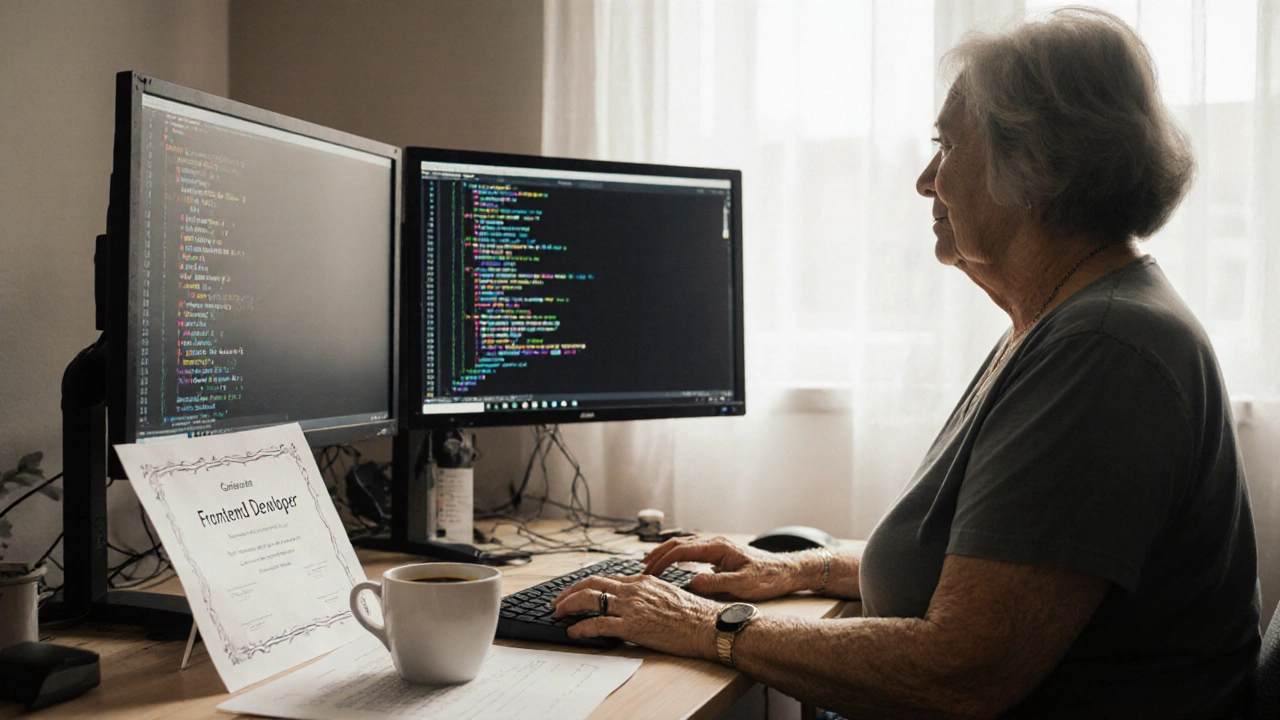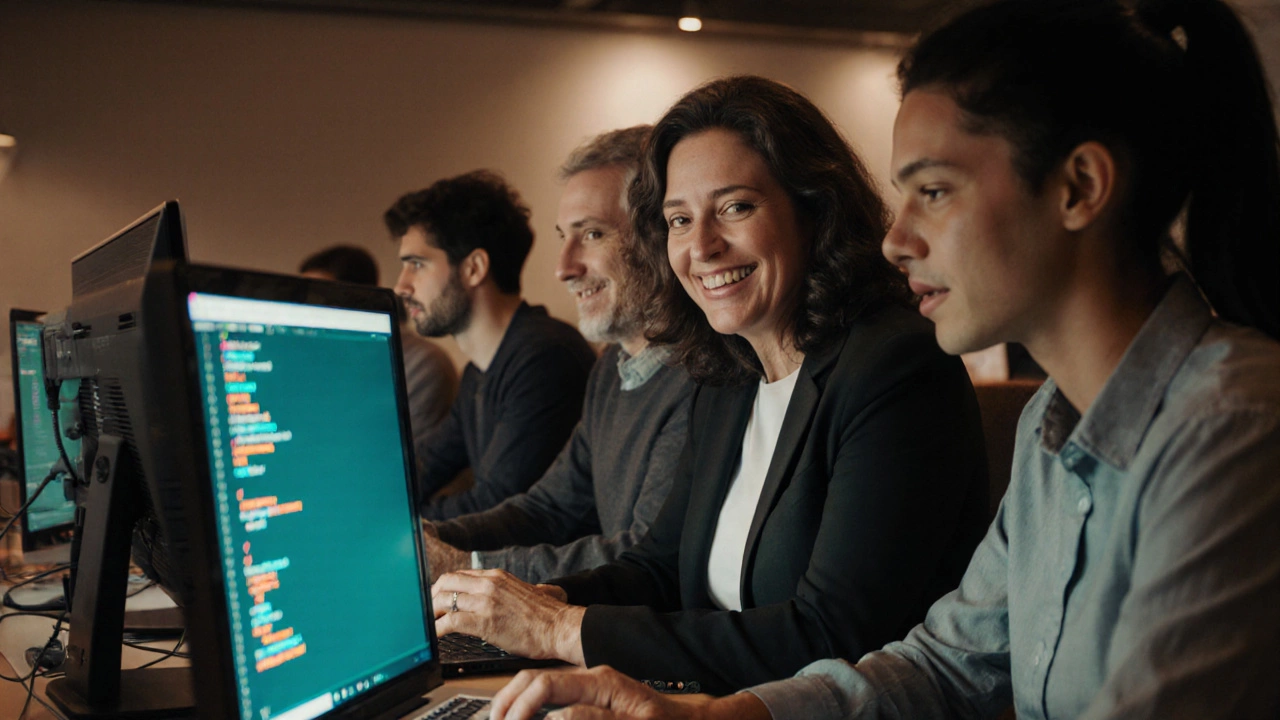Coder Age Estimator
The average age of a professional coder today is 38 years, according to Stack Overflow's 2025 Developer Survey. This tool helps you understand where your age fits in the modern coding workforce.
Age is just a number—many successful developers start coding later in life.
Your Age in the Coding World
Enter your age to see how it compares
When you think of a coder, what comes to mind? A teenager typing furiously in a hoodie? A mid-30s parent working remotely? Or maybe someone in their 50s switching careers after decades in another field? The truth is, there’s no single face to a coder anymore. The average age of a programmer today is 38, according to Stack Overflow’s 2025 Developer Survey, which polled over 90,000 developers across 180 countries. That’s older than most people assume-and it’s only getting older.
Why the Average Coder Is Older Than You Think
A decade ago, the stereotype of a coder was a 20-something college dropout or recent grad. That image still lingers in movies and startup hype, but reality has shifted. The tech industry no longer just hires fresh talent-it needs experience. Companies now look for developers who can debug complex systems, lead teams, and understand business needs-not just write clean code. The rise of legacy systems in banking, healthcare, and government has created a massive demand for coders who know older languages like COBOL, Java, and C#. These aren’t trendy languages taught in bootcamps. They’re the backbone of critical infrastructure, and the people who know them are often in their 40s and 50s. A 2024 report from the Bureau of Labor Statistics found that nearly 42% of software developers in the U.S. are over 40, up from just 28% in 2015.Age Isn’t Just About Experience-It’s About Lifelong Learning
Many people assume you have to start coding young to succeed. That’s not true. People switch into tech at every stage of life. In 2025, one in five new coders enrolled in online courses was over 45. Some are former teachers, mechanics, nurses, or military veterans. They didn’t start with Python at 16-they started after a layoff, a career plateau, or a personal interest sparked by a pandemic. Coding classes today are designed for adults. Platforms like freeCodeCamp, Coursera, and Udacity don’t assume you’ve ever touched a computer. Their courses walk you through installing software, understanding basic logic, and building your first app-even if you’re 52 and haven’t opened Excel since 2010. The dropout rate for these adult learners is lower than you’d expect. Why? Because they’re motivated by real goals: a new job, financial security, or the chance to build something meaningful.What’s Happening in Coding Bootcamps?
Bootcamps still attract younger students, but their demographics are changing. In 2023, the average age of a full-time coding bootcamp student in the U.S. was 31. By 2025, that number had climbed to 34. That’s not a fluke. More mid-career professionals are enrolling, often with employer sponsorship. Companies like IBM, Accenture, and Amazon now fund internal retraining programs for employees in non-tech roles. One bootcamp in Chicago reported that 38% of its 2024 cohort had previously worked in sales or customer service. Another in Atlanta had a 57-year-old former high school principal graduate first in her class. She now works as a frontend developer for a health tech startup. Her story isn’t rare-it’s becoming the norm.
Why Age Matters in Team Dynamics
Teams with mixed-age coders perform better. A 2023 MIT study found that teams with members aged 30-50 solved complex problems 22% faster than teams made up entirely of developers under 25. Why? Older coders bring context. They’ve seen systems fail, survived tech booms and busts, and learned how to communicate with non-technical stakeholders. Younger coders bring energy and familiarity with new tools. Together, they balance each other. The best tech teams aren’t age-homogeneous. They’re age-diverse. That’s why companies are ditching “culture fit” in favor of “culture add.” They want people who’ve lived different lives, not just people who went to the same university.Challenges for Older Coders
It’s not all smooth sailing. Ageism in tech is real. Job postings that say “recent graduate preferred” or “digital native” are still out there. Recruiters sometimes assume someone over 40 won’t keep up with new frameworks. But data says otherwise. A 2025 survey by GitHub showed that developers over 40 contributed to more open-source projects per year than those under 25. They just don’t post on Twitter about it. The real barrier isn’t skill-it’s perception. Older coders often struggle to get interviews, not because they can’t code, but because their resumes look “too traditional.” That’s why many now build portfolios on GitHub, create personal blogs, or contribute to documentation. They prove their value through work, not buzzwords.
Where the Next Wave of Coders Is Coming From
The fastest-growing group of new coders isn’t college students. It’s people over 50. In the U.K., the number of adults over 55 taking free online coding courses doubled between 2023 and 2025. In Germany, public libraries now offer free weekly “Code for Seniors” workshops. In Japan, retired engineers are mentoring teens while learning React themselves. This isn’t a trend-it’s a demographic shift. As automation replaces routine jobs, more people are turning to coding as a second career. And unlike other fields, coding doesn’t require a degree. You don’t need to go back to school for four years. You just need a laptop, internet, and the will to keep going after your first bug crashes your app for the third time.What This Means for You
If you’re thinking about learning to code, don’t let age hold you back. Whether you’re 17 or 67, the tools are the same. The resources are free. The community is welcoming. The demand is real. If you’re hiring, stop looking for the “youngest, fastest coder.” Look for the one who can explain why a system broke, who remembers how to fix it without Google, and who can teach someone else how to do it too. If you’re a teacher or bootcamp instructor, design your curriculum for adults. Use real-world examples. Talk about salary, job hunting, and work-life balance-not just syntax. Your students aren’t kids. They’re people with responsibilities, fears, and dreams.Final Thought: You’re Never Too Old to Start
The average coder is 38-not because everyone started at 18, but because people keep learning, changing, and adapting. The future of coding isn’t just about the next big framework. It’s about the next generation of learners, no matter when they begin.Is 30 too old to start learning to code?
No, 30 is not too old. In fact, it’s the average age of many professional developers. Many people start coding in their 30s after working in other fields. The key isn’t age-it’s consistency. With 10-15 hours a week, most people can land an entry-level job within 6-12 months.
Are there coding jobs for people over 50?
Yes, and they’re growing. Many companies need developers who understand legacy systems, compliance, and user experience-skills often developed over decades of work. Roles like technical writer, QA engineer, and legacy system maintainer are especially open to older candidates. Remote work has also made it easier for older professionals to find flexible positions.
Do older coders struggle to keep up with new technologies?
Not more than younger coders. Everyone learns at their own pace. A 2025 GitHub study found that developers over 40 spent more time mastering tools deeply rather than chasing every new framework. They focus on what works, not what’s trendy. Many older coders become experts in specific areas like security, data architecture, or accessibility-areas where experience matters more than speed.
What’s the best way for an adult to learn to code?
Start with a clear goal: build a website, automate a task, or get a job. Then pick one language and stick with it for at least 3 months. FreeCodeCamp, The Odin Project, or Codecademy’s Pro plan are great for beginners. Join a local or online study group. Practice daily-even 20 minutes helps. Build small projects that solve real problems in your life. That’s how you learn faster than any course can teach you.
Why do so many coding bootcamps advertise for 18-24 year olds?
Because that’s who they used to target. Many bootcamps still use outdated marketing that assumes coders are young, single, and have no responsibilities. But the market is shifting. More bootcamps now offer part-time, evening, and remote options specifically for working adults. Look for programs that highlight career changers, flexible schedules, and job placement for all ages-not just recent grads.
